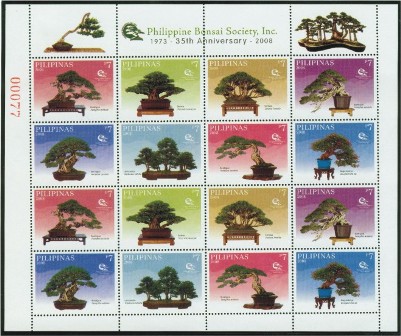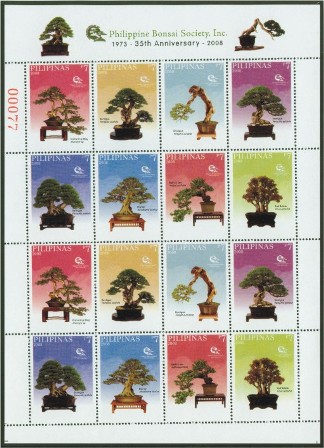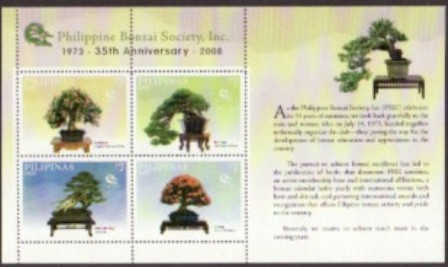2008, October 17. Philippine Bonsai Society, Inc. - 35th Anniversary
Litho Offset. Amstar Company, Inc. Perf. 14
Se-tenant Blocks of 8: Miniature Sheets of 16 Horizontal & Vertical Formats; Souvenir Sheets of 4


Se-tenant Blocks of 8 (20,000 Horizontal) (left to right with owner's name)
7p Icamuning Bilog (Murraya-sp.) (Fely S. Gupit)
7p Bantigue (Pemphis acidula) (Ogi Uyehara)
7p Bantigue (Pemphis acidula) (Emer Cruz)
7p Bantigue (Pemphis acidula) (Jun Balderama)
7p Bantigue (Pemphis acidula) (Bobby Gopiao)
7p Bignay (Antidesma bunius) (Romy Dino)
7p Bantulinaw (Maba buxifolia) (Teddy Lim)
7p Red Balete (Ficus concina) (Oding Reyes)
Miniature Sheets of 8 (20,000 Horizontal)
Se-tenant Blocks of 8 (20,000 Vertical) (left to right with owner's name)
7p Bantigue (Pemphis acidula) (Bobby Gopiao)
7p Balete (Ficus microcarpa) (Charlie Li)
7p Serissa (Serissa foetida) (Bencab)
7p Bantigue (Pemphis acidula) (Apollo Ferrer)
7p Bantigue (Pemphis acidula) (Pabling Dychitan)
7p Lemonsito (Triphasia trifolia) (Fely S. Gupit)
7p Bantigue (Pemphis acidula) (Joel Embuscado)
7p Bogambilya (Bougainville sp.) (Bobby Gopiao)
Miniature Sheets of 8 (20,000 Vertical)
Souvenir Sheets of 4 (6,500)
7p Melindres (Lagerstroemia indica) (Fely S. Gupit)
7p Bantigue (Pemphis acidula) (Bobby Gopiao)
7p Mulawin Daga (Vitex sp.) (Fely S. Gupit)
7p Santan (Ixora chinensis) (Bobby Gopiao)
Designer/Graphic Designer: Aman Santos
Design Coordinators: Bobby P. Gopiao, Yumie S. Gupit, Dr. Ngo Tiong Tak
Photographer: Erwin C. Obcemea
First Day Covers: Manila
PHILIPPINE BONSAI SOCIETY, INC - 35th ANNIVERSARY
The Philippine Bonsai Society, Inc. has become what it is today - the premiere bonsai organization in the country, because of the passion and dedication of our members, the unconditional love of our families, the support of friends and generous contribution of individuals who have taken that continuing journey with us, and shared our vision of putting the Philippines in the international map of Bonsai Excellence.
The Philippine Bonsai Society, Inc. (PBSI) was formally organized on July 14, 1973 with Rose Laurel Avancena as Founding President, and Serapion "Mett" Metilla initiating the formation of the club with the encouragement of fellow plant lovers.
Nurtured with love and strengthened by the resolve to achieve the goals outlined in the PBSI Constitution, the years have seen the rise in membership and the spread of knowledge and appreciation in the art of growing miniature trees. The club also keeps in touch globally by being open to the trends and norms that mark the artistic approach to the ideals of bonsai.
It also makes a strong presence in international conventions, particularly in Asia, and has won honors for the country in various international bonsai competitions.
Former PBSI President Aurora Villanueva (1776-1977) summed up the feelings best - "As true to all bonsai, its beauty is reflected in the number of years that it has existed, the older it gets, the more beautiful it becomes. So too with the Philippine Bonsai Society".
ICAMUNING BILOG (Murraya sp.) - Found in lowland forests, the specie grows as a shrub to a small-sized tree. The woody fissured trunk, leathery and glossy dark leaves and easy propagation by cuttings make it an excellent specie to train as bonsai
BANTIGUE (Pemphis acidula) - Concededly the crowning glory of Philippine bonsai according to many local and foreign bonsai observers. This sought after specie is indigenous in Indo Malaya. In the Philippines, they usually grow in coralline rocks along coastal areas. Small leaves, fissured trunk and a well defined rootage gives it inherent beauty that inspire bonsai artists to train show quality and award-winning trees.
BIGNAY (Antidesma bunius) - Indigenous to India and the Malay Peninsula, this specie grows as a small medium-sized tree and propagated by seeds. Leaves are oblong shaped with glossy green surface. Bonsai artists are rewarded with both flowers clustered on spike, and fruits that are edible, acidic and red when ripe.
BANTULINAW (Maba buxifolia) - Found in forests as erect shrubs or tender evergreen trees with glossy alternate leaves and small white flowers in May, and fruits in June-July which turn red as they mature. The bonsai artist is challenged by the virtue of patience due to the slow-growing characteristics of the species. Everything, however, is compensated by the projection of an ancient tree as seen in its unique black bark, shiny leaves and well defined rootage.
RED BALETE (Ficus concina) - The specie is widely found in thickets in Philippine forests. Characterized by a spreading crown and fiery red young leaves that turn leathery dark green when leaves mature. It gives an "autumn feel" and becomes a dramatic red standout in a bonsai garden filled with miniature green leafy trees.
BALETE (Ficus microcarpa) - A spreading tree with leathery smooth and glossy leaves. Native to South China and introduced to the Philippines as a worthy addition to a bonsai collection because of several inherent characteristics : textured bark, vigorous growth resulting in ease of developing good branching and twigging, leaf size that can successfully respond to reduction by constant defoliation, and a full canopy that contributes to an impressive bonsai design, banyan style.
SERISSA (Serissa foetida) - Small shrubs with glossy ovate leaves. Widely distributed in Southeast Asia and introduced in the Philippines. Widely propagated by stem cuttings, the specie was first used for topiaries and dish gardens. As material for bonsai, enthusiasts find delicate beauty and grace in its gnarled trunk and long and frequent blooming of small white flowers.
LEMONSITO (Triphasia trifolia) - Found in thickets through out the islands, the lemonsito is cultivated as an ornamental and as a good material for bonsai. Flowers are white, solitary and fragrant. The fruits which appear as berries are globose and grow up to 2 cm in diameter and red when ripe. Makes an attractive bonsai especially when studded with berries.
BOGAMBILYA (Bougainville sp.) - The genus was named after Antoine de Bougainville, first Frenchman to cross the Pacific. Native to South America, numerous cultivars are now cultivated in the Philippines consisting of single or many bracts and various colors. One of the most popular ornamental plants in the country and a favorite flowering bonsai specie due to its showy flowers that grows so well in tropical climate.
MELINDRES (Lagerstroemia indica) - Genus name in honor of Magnus V. Lagerstroem, a Swedish friend of Carolus Linnaeus, Swedish botanist and founder of the Modern Classification System for Plants and Animals. Native to China and occasionally planted in Philippine gardens but not widespread. As a still relatively rare specimen for bonsai in the Philippines, it is a sight to behold a miniature tree with slender branches and showy flowers that appear clustered in pink or purple.
MULAWIN DAGA (Vitex sp.) - A small to medium-sized tree indigenous to Southeast Asia, this specie is favored as a good material for bonsai owing to its smooth, shiny dark green leaves and vigorous growth, thus making it possible to achieve show trees within a reasonable time frame.
SANTAN (Ixora chinensis) - Widespread in India, Malay Peninsula and China, the specie was introduced to the Philippines and popularly cultivated as an ornamental in parks, street islands and residential gardens. Leaves are fresh green above and pale green beneath, the flowers appear in dense clusters in light orange-red, yellow or white. The first appearance of an Ixora chinensis and subsequent awards in bonsai competitions created the impetus for bonsai artists to appreciate the qualities of this specie as stunning flowering bonsai.
-
Forestry / Trees
